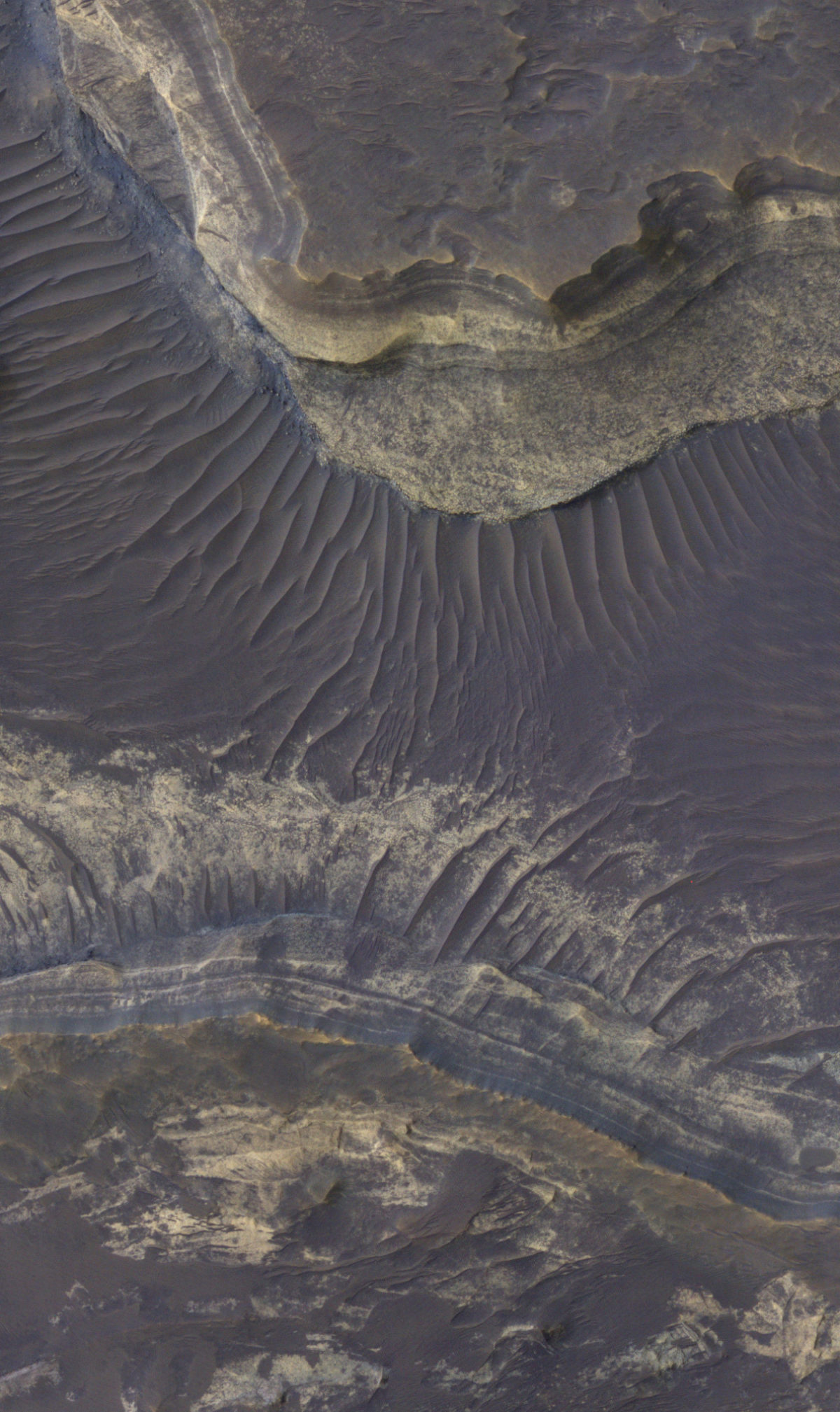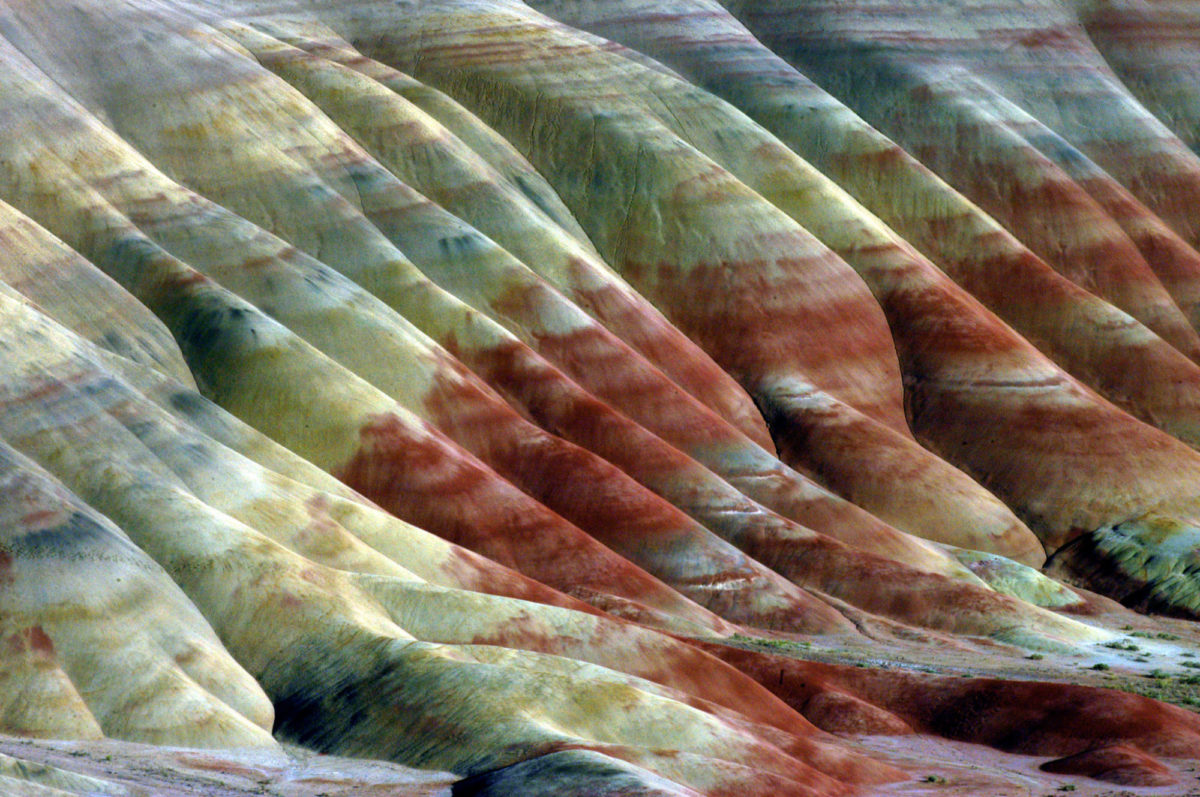Emily Lakdawalla • Mar 28, 2013
LPSC 2013: watery Martian minerals
I spent Thursday last week in two different flavors of water-on-Mars sessions. In the morning was a session on the mineralogy of Martian aqueous environments; the afternoon was about ice, glaciers, and polar processes on Mars.
Mineralogy is a difficult topic to cover from the outside because there is so much information encoded in the names of minerals. If you forget what a mineral is made of, you lose a whole lot of important context. I've got a leg up on most space bloggers in this area because I've taken (and T.A.'d) mineralogy and petrology classes. Every time I meet astronomer/educator/blogger Pamela Gay in the hallways at a planetary geology meeting, she always mutters to me about "Olivine. What's so important about olivine?"
I know what olivine is (it's an iron-magnesium silicate mineral, one of the most commonly occurring minerals in the solar system, which crystallizes from rock melts at high temperatures and breaks down rapidly in the presence of water into other minerals, so it's a marker for relatively primitive, unaltered rocks). But when people start talking about smectite and kaolinite and nontronite and saponite I know vaguely that they're all clay minerals (so water is important) but I can't remember the differences among them without recourse to Google. Therefore, my understanding of many of these talks hinged on how much the speakers assumed the audience would understand just by being told the name of a mineral. I did well when they talked about elements (e.g. aluminum- or magnesium-rich flavors of this or that) and poorly when they just bandied about mineral names (what is beidellite?)
I thought John Carter's presentation on widespread surface weathering on Mars was interesting. He used Mars Reconnaissance Orbiter CRISM spectral data to find signatures of the presence of clay minerals across Mars, and then looked at patterns of the occurrence of different flavors of clay mineral. He found, first of all, that aluminum-rich clay minerals (kaolins and smectites) occurred in about half of the locations, while 90% of them contained iron and magnesium clays. Looking more closely at their exposures, he found two interesting things: the iron/magnesium clay exposures were always thicker than the aluminum-rich ones, and furthermore, the aluminum-rich ones are stratigraphically higher than the iron-rich ones. He suggested that these were similar to Earth mineralogic sequences formed when rocks get rained on: that is, these rocks started out with a different mineral composition, and that wetting and weathering and leaching removed the iron and magnesium from the top of the sequence, leaving the layered clay signatures that we see now. That implies two important things: that there was a weathering environment that was at least transiently wet over millions of years, and that the clay minerals we see in these rocks are not original to the rocks, but are rather a product of alteration that came later, after the rocks formed. These are some of the kinds of pretty layered rocks he was showing in his talk:

Erwin Dehouck approached the question of weathering of basaltic rocks on Mars from a different direction: experiment. Unlike a lot of the complicated experiments I've seen summarized at conferences, this one was endearingly basic. He had four jars of ultrapure water, in which he placed powdered magnesium-rich olivine. The air in two of the jars was just plain air. In the other two, it was carbon dioxide. Then, in one of each, he added a small amount of hydrogen peroxide, a powerful oxidizer that's known to be present in Mars' soil and atmosphere. Then he waited for three months, and then investigated with a variety of analytical tools what happened to the olivine grains. He found some interesting things. It's generally assumed that if you weather minerals under a carbon dioxide atmosphere, you'll get carbonate minerals; so it's been a surprise that so few exposures of carbonate minerals have been found on Mars. Dehouck found that under a carbon dioxide atmosphere, almost all of the weathering products from olivine were in the form of amorphous silicate minerals. In fact, these kinds of minerals have been found all over Mars both from orbit and on the ground. Even clay minerals were more abundant in the weathering products under carbon dioxide than carbonates. But in the presence of the oxidizing hydrogen peroxide, neither clay nor carbonate minerals formed; pretty much only amorphous silica, with a teeny amount of iron hydroxides.
Briony Horgan presented a suggested Earth analog for the interesting sequences of clay minerals observed at Mawrth Vallis. Mawrth is one of the sites that was considered for Curiosity but lost out to Gale; because its most vocal advocates were the European contingent of the Mars community on the Mars Express OMEGA team, I would be shocked and amazed if ESA's ExoMars mission is not sent to a landing site there. Horgan talked about the painted hills of the John Day Fossil Beds as an analog. These are volcaniclastic rocks, meaning that they're sedimentary rocks laid down in a layered sequence, but the sediment is volcanic ash. She pointed out that every one of the exposed layers in these rocks represents a paleo-surface. This is in contrast to the layered clays Carter was talking about in his presentation, where the "layers" are actually just different levels of alteration inside rocks that mostly were not exposed at the surface when the clay minerals formed. The story Horgan told about Mawrth based on the patterns of different clay mineral exposures was a complex one, but her point was that there is a diverse mineralogy that spoke of a sustained semi-arid climate for tens of millions of years, with a wide variety of geochemical mini-environments providing "many pathways for life." To top it off, the aridity and the reducing (rather than oxidizing) chemical conditions make them great environments for preservation of organic molecules. I was sold on Mawrth being an excellent place to send a rover.

I sat in the session for a couple more talks but as they were less closely tied to things I knew about, I got less out of them.
The Time is Now.
As a Planetary Defender, you’re part of our mission to decrease the risk of Earth being hit by an asteroid or comet.
Donate Today

 Explore Worlds
Explore Worlds Find Life
Find Life Defend Earth
Defend Earth

